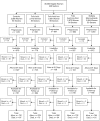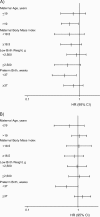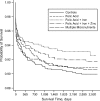Antenatal and postnatal iron supplementation and childhood mortality in rural Nepal: a prospective follow-up in a randomized, controlled community trial
- PMID: 19778983
- PMCID: PMC2781740
- DOI: 10.1093/aje/kwp253
Antenatal and postnatal iron supplementation and childhood mortality in rural Nepal: a prospective follow-up in a randomized, controlled community trial
Abstract
The long-term benefits of antenatal iron supplementation in child survival are not known. In 1999-2001, 4,926 pregnant women in rural Nepal participated in a cluster-randomized, double-masked, controlled trial involving 4 alternative combinations of micronutrient supplements, each containing vitamin A. The authors examined the impact on birth weight and early infant mortality in comparison with controls, who received vitamin A only. They followed the surviving offspring of these women at approximately age 7 years to study effects of in utero supplementation on survival. Of 4,130 livebirths, 209 infants died in the first 3 months and 8 were lost to follow-up. Of those remaining, 3,761 were followed, 150 died between ages 3 months and 7 years, and 152 were lost to follow-up. Mortality rates per 1,000 child-years from birth to age 7 years differed by maternal supplementation group, as follows: folic acid, 13.4; folic acid-iron, 10.3; folic acid-iron-zinc, 12.0; multiple micronutrients; 14.0; and controls, 15.2. Hazard ratios were 0.90 (95% confidence interval (CI): 0.65, 1.22), 0.69 (95% CI: 0.49, 0.99), 0.80 (95% CI: 0.58, 1.11), and 0.93 (95% CI: 0.66, 1.31), respectively, in the 4 supplementation groups. Maternal iron-folic acid supplementation reduced mortality among these children by 31% between birth and age 7 years. These results provide additional motivation for strengthening antenatal iron-folic acid programs.
Figures



References
-
- McLean E, Cogswell M, Egli I, et al. Worldwide prevalence of anaemia, WHO Vitamin and Mineral Nutrition Information System, 1993–2005. Public Health Nutr. 2009;12(4):444–454. - PubMed
-
- Stoltzfus RJ. Iron-deficiency anemia: reexamining the nature and magnitude of the public health problem. Summary: implications for research and programs. J Nutr. 2001;131(suppl):697S–700S. - PubMed
-
- Stoltzfus RJ, Dreyfuss ML. Guidelines for the Use of Iron Supplements to Prevent and Treat Iron Deficiency Anemia. Washington, DC: International Life Sciences Institute; 1998.
-
- Cogswell ME, Parvanta I, Ickes L, et al. Iron supplementation during pregnancy, anemia, and birth weight: a randomized controlled trial. Am J Clin Nutr. 2003;78(4):773–781. - PubMed
Publication types
MeSH terms
Substances
Grants and funding
LinkOut - more resources
Full Text Sources
Medical

